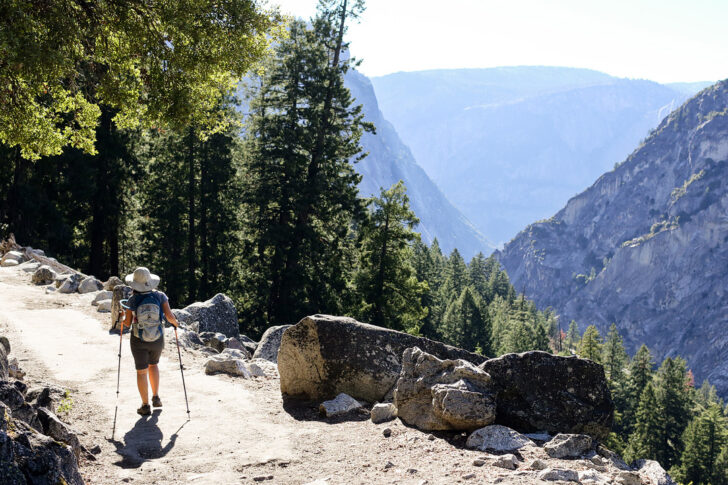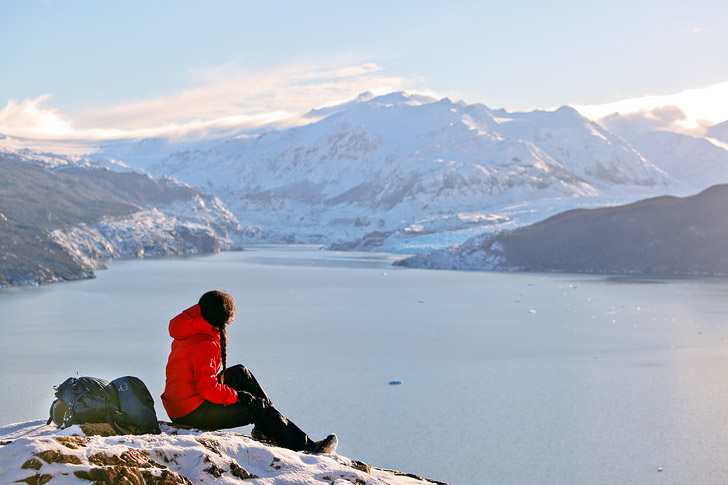Torres del Paine National Park (or Parque Nacional Torres del Paine) is a national park in Southern Chilean Patagonia and has been getting more popular every year. Anyone who witnesses the dramatic mountains, blue glaciers, pristine lakes and rivers, and spectacular landscapes knows why this place is so special. It’s truly one of the most beautiful places on earth.
TIP: In case you’re not sure how to pronounce Torres del Paine, it’s tOH-rehs del PIE-nay and it means Towers of Blue.
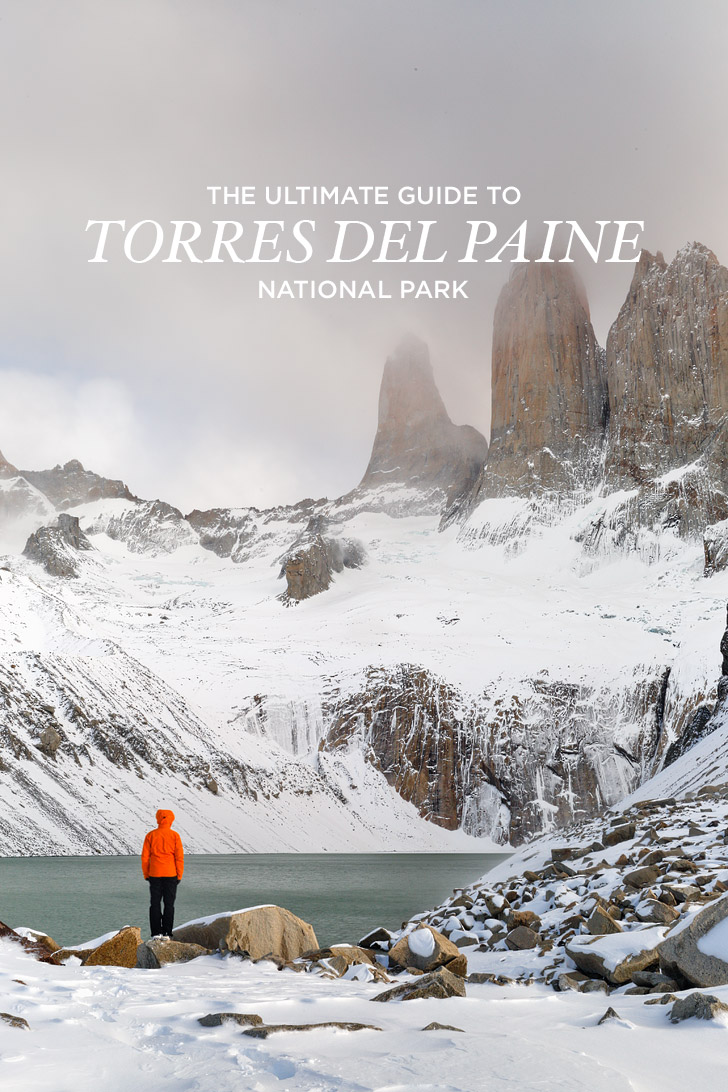 Pin
PinThis trip was made possible by One Seed Expeditions. All opinions are always our own. This post may contain affiliate links, where we receive a small commission on sales of the products that are linked at no additional cost to you. All opinions are always our own. Read our full disclosure for more info. Thank you for supporting the brands that make Local Adventurer possible.
Last Updated: May 27, 2020
Ultimate Guide to Torres Del Paine National Park Chile
Best Things to See and Do
- Activities – Hiking, Glacier Hiking, Climbing, Ice Climbing, Kayaking, Fishing, Horseback Riding
- Mountains – Torres del Paine (Granite Towers), The Cuernos (Horns), Paine Grande, French Valley
- Glaciers – Grey Glacier, Dickson Glacier, French Glacier, Pingo Glacier, Zapata Glacier, Tyndall Glacier
- Lakes & Rivers – Grey Lake, Pehoe Lake, Serrano River, Nordenskjold Lake, Salto Grande Waterfall, Paine River, Toro Lake
Best Hikes in Torres Del Paine National Park
Torres del Paine W Circuit
This hike has become synonymous with Torres del Paine National Park. It’s named after the shape of the route, and it takes you to the most iconic spots in the park. See full guide here.
Torres del Paine O Circuit
The O Circuit includes the W, but takes you further out into the wilderness and away from people. Many of the volunteers we talked to hiked it in four days, but most people go at a more leisurely pace.
Torres del Paine - The Granite Towers (Day Hike)
This is the most iconic view in Patagonia. It’s part of the W Circuit but also brings in tons of day-hikers. During the summer season, you’ll find anywhere from 800-1000 people on the trail.
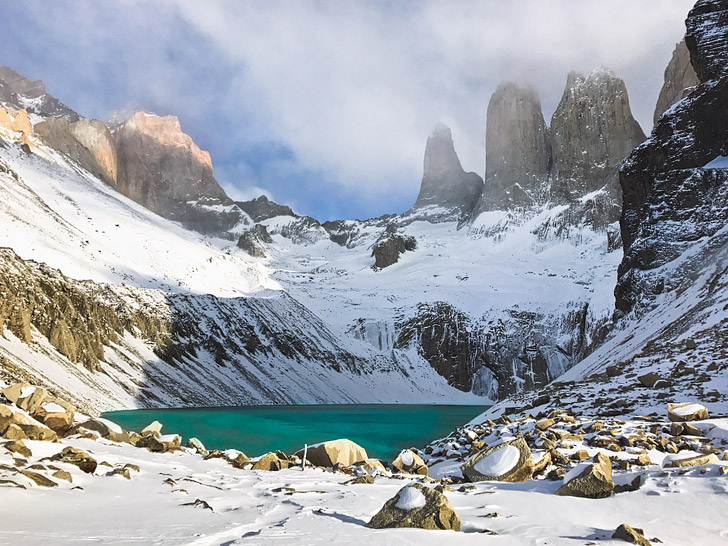 Pin
PinGrey Glacier Hike (Day Hike)
We saw a poster that said “The Bluest Grey You’ll Ever See” which is a great description of the Grey Glacier. This hike takes you to a viewpoint and then down to the lake to get a closer view.
 Pin
Pin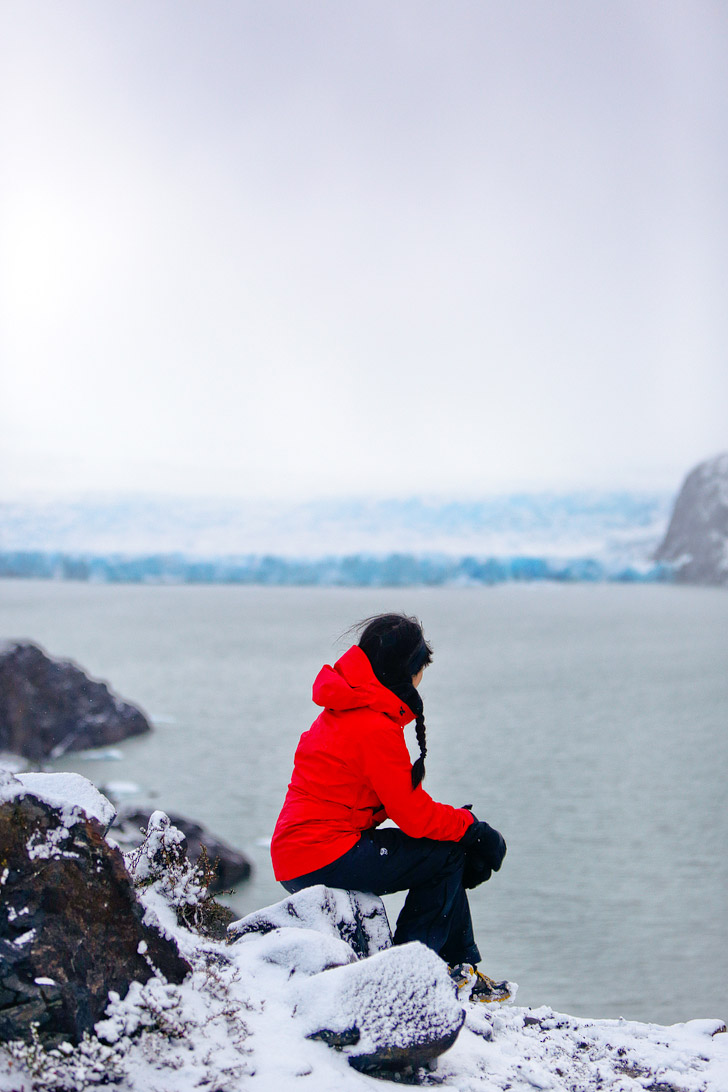 Pin
PinValle de Frances or 'French Valley' (Day Hike)
The valley gets you into the heart of the national park and surrounds you with towering peaks.
French Glacier Hike (Day Hike)
On our third day, we were supposed to hike further into the French Valley but the weather wasn’t great so our guide took us to the French Glacier instead. It was one of our favorite spots!
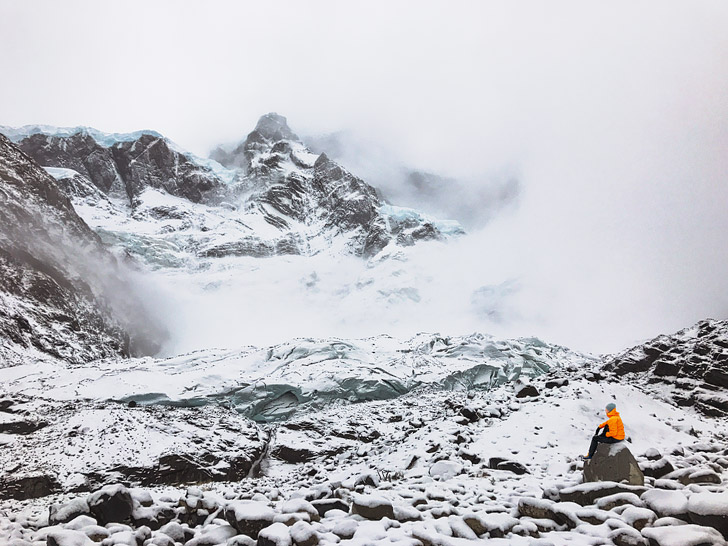 Pin
PinTorres del Paine Map
 Pin
PinCan you see why they call it the W?
About the Park
Torres del Paine National Park is one of the most iconic parts of Patagonia and is entirely in Chile, while the greater Patagonia territory covers both the southern part of Chile and Argentina.
Geology
The geology at Torres del Paine National Park is unique because there is such a clear distinction between the granite and sedimentary rocks. Cuernos del Paine or the Horns is a great example. Typically glaciers will grind away any sedimentary rocks leaving only the granite for us to appreciate, but in this case, there is still a clear layer of sedimentary rock at the top.
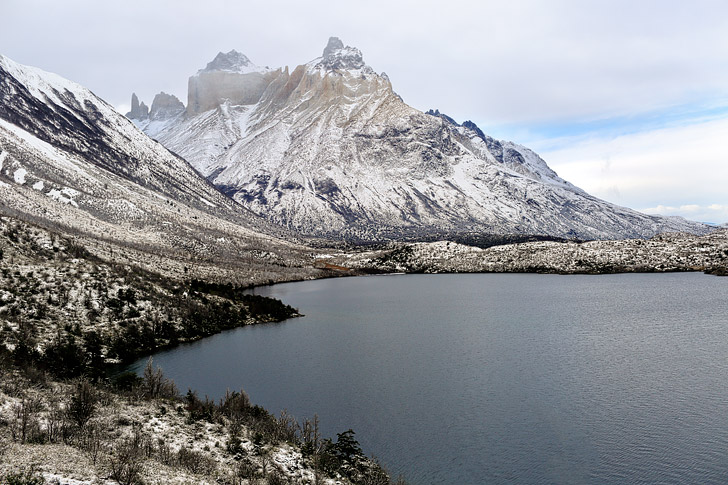 Pin
PinWildlife
Guanacos (a relative of the llamas), hares, pumas, and foxes are common in the park, although you’ll rarely see the latter two. If you’re lucky, you’ll also get a glimpse of the endangered Andean Deer. We saw two, and we knew it was a big deal when our guide who has hiked the W over 200 times got excited. He’s only seen them one other time.
You’ll find Andean condor, Black-chested Buzzard eagle, rufous-tailed hawk, Cinereous harrier, Chimango caracara, austral pygmy-owl, and more if you look up at the sky or in the trees. During our trip, we spotted two pumas far away from us and saw puma tracks everywhere especially on the hike to Grey Glacier.
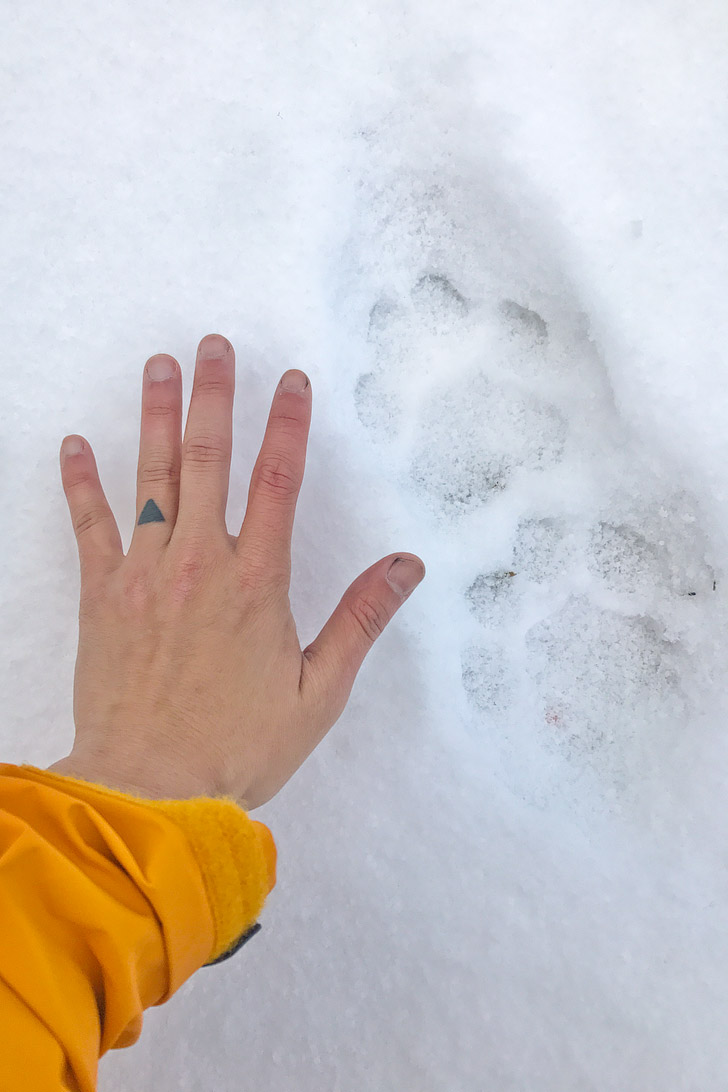 Pin
Pin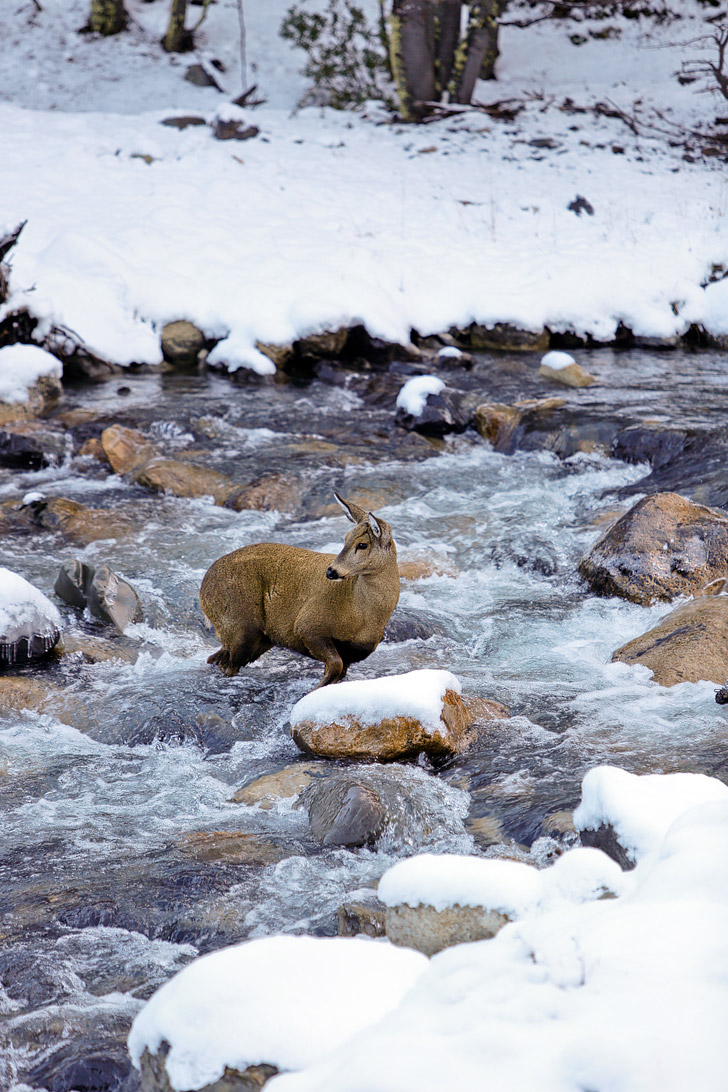 Pin
PinGetting to Torres del Paine
It’s not easy to get to the national park. Unless you’re a local, you’ll need to take a combination of flights, ground transportation, and maybe even a boat to get there.
Where is Torres del Paine Located?
Torres del Paine is located 70 mi (112 km) north of Puerto Natales and 194 mi (312 km) north of Punta Arenas. The Los Glaciares National Park lies along its northern border and Bernardo O’Higgins National Park is to the west.
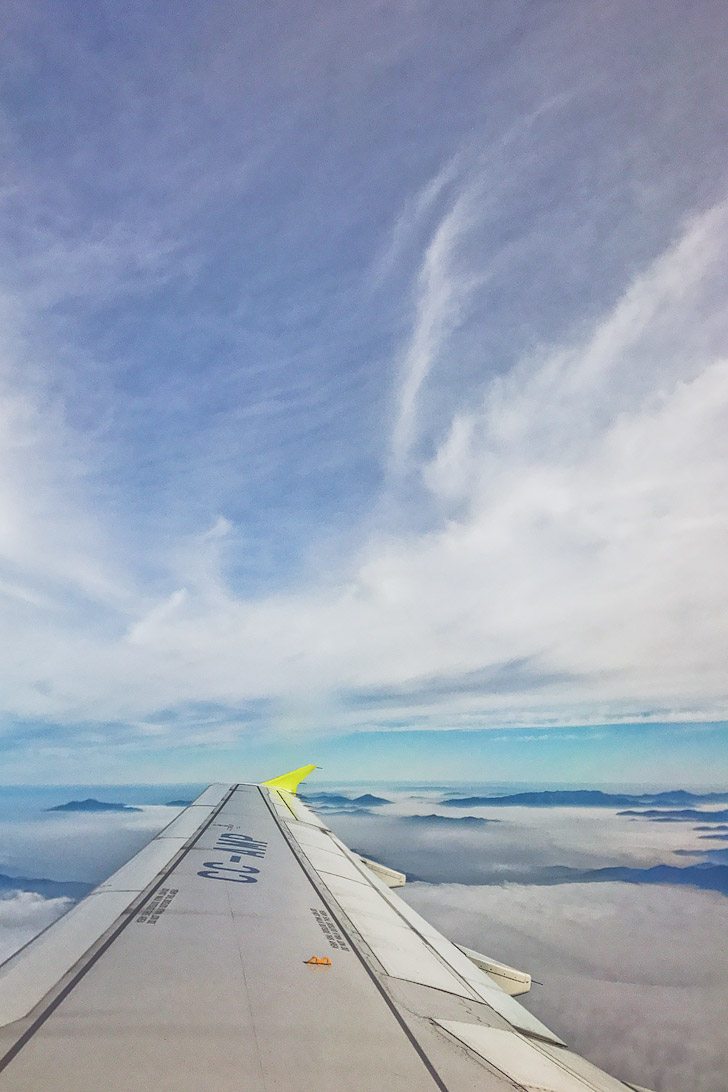 Pin
Pin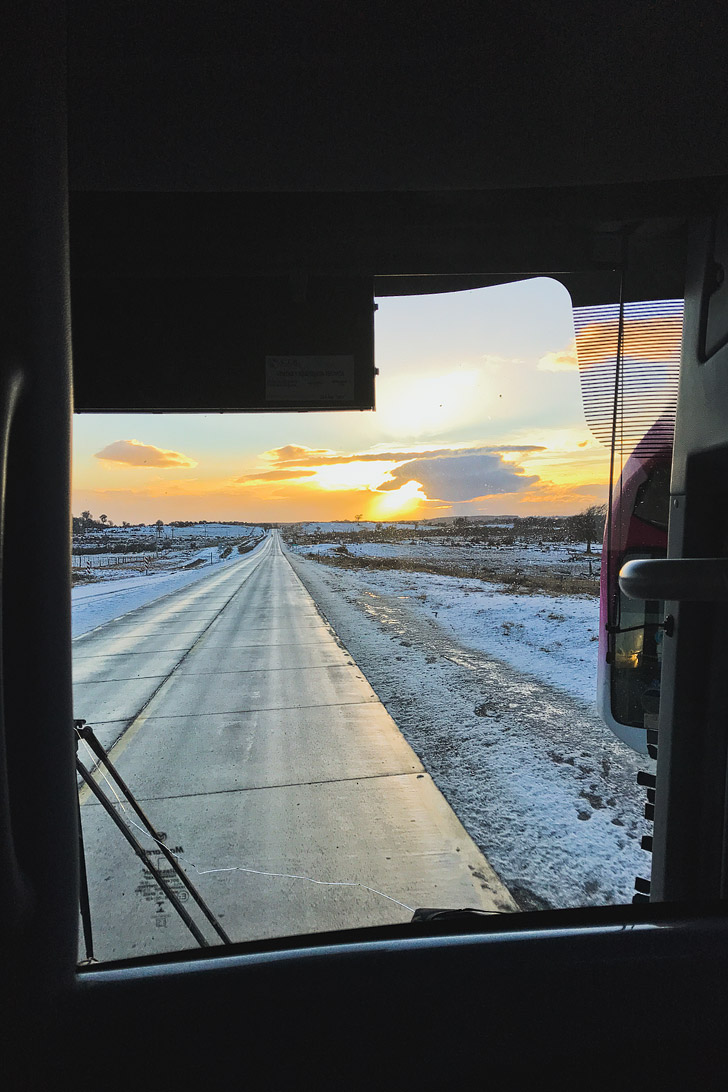 Pin
PinBy Air
Punta Arenas is the closest airport to Torres del Paine. Most people fly into Santiago, Chile and then take a domestic flight to Punta Arenas, which is roughly 3.5 hours on a direct flight.
You can also come from the Argentina side. From Buenos Aires, there are no direct flights to Punta Arenas, so most people fly to El Calafate then take a bus or rental car to Puerto Natales, which is 350 km or 4.5 hours.
By Ground
You still need to get to Puerto Natales after flying into Punta Arenas. The easiest way to do this is a 3 hours bus ride. Once you arrive in Punta Natales, you’re still not quite there. There are two main routes from Puerto Natales to Torres del Paine National Park.
- Take Route 9, a paved road, to the Arimiento (69.5 mi / 112 km) and Laguna Amarga (180 mi / 129 km) entrances
- Take Route Y-290, a gravel road, to the Serrano entrance (50 mi / 80 km)
Pro Tip: If you go with OneSeed (use LOCAL10 when booking for 10% off), they take care of your ground transportation and accommodations for you.
Torres Del Paine Catamaran
For those of you who are hiking or staying at the Refugio Paine Grande, there is a catamaran that runs between Pudeto Jetty and Refugio Paine Grande. Be sure to stop by to check the schedule since no reservations can be made.
Best Time to Visit Patagonia
High season is October through April and low season is May to September. Of that, the most popular time to visit Torres del Paine is between December to February. Long hours of daylight and warm temperatures make the hike easier, but it also means that everyone is at the park. 80-90% of the annual 252,000 visitors are there during those warmer months.
Winter, on the other hand, is when the guides fall in love with the park again. We only saw 1 other hiker on the trail up to the Granite Towers, which will typically have anywhere between 800-1000 hikers during the busy season. Another guide joked if you were greeting other hikers, you’ll be saying “hi-hi-hi-hi-hi-hi” nonstop, and that’s only a slight exaggeration.
Our opinion, go in the winter! The only downside was that the days are shorter, and we had to pick up our pace when hiking. I was worried about the cold, but it didn’t end up being as bad as I anticipated, and it was completely worth having the whole park to ourselves.
 Pin
PinTorres Del Paine NP Hours
- Serrano Entrance: 7 am to 10 pm (Oct to April), 8:30 AM to 5:30 PM (May to Sept)
- Armiento Entrance: 7 am to 10 pm (Oct to Apr), 8:30 AM to 5:30 PM (May to Sept)
- Laguna Amarga Entrance: 7 am to 10 pm (Oct to Apr, -8:30 AM to 5:30 PM (May to Sept)
Torres Del Paine Entrance Fee
- Adults: CH$ 21.000 (Oct to Apr), CH$ 11.000 (May to Sept)
- Children: CH$ 6.000 (Oct to Apr), CH$ 1.000 (May to Sept)
Torres Del Paine Weather
- Weather is unpredictable! Most of the locals will tell you that you can experience four seasons in one day, and we can confirm that based on our experience.
- Summers (Dec-Feb) are cool at the park with temperatures around 61 °F (16 °C ).
- Winter (Jun-Aug) is much colder with an average high of 41 °F (5 °C) and an average low of 27 °F (−3 °C).
- The wettest months are March and April when the average rainfall is almost double the “drier” months between July and October.
- Torres del Paine Wind should not be taken lightly. We had no idea that winds can reach up to 110 mph (180 kph) in the park. That’s strong enough to take people airborne. The highest winds typically happen during the summer, while winter is commonly characterized by a calmer wind. During our hike, we had what we thought were powerful gusts, but our guide told us it was nothing in comparison to summer winds.
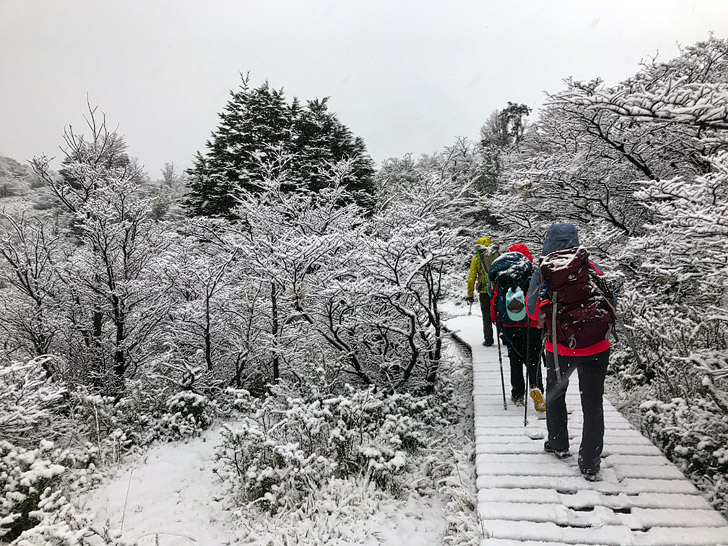 Pin
PinEssential Tips for Visiting Torres del Paine National Park
- A guide is required during the winter and highly recommended at any season. They can give you amazing insight to the park. Go with a guide company like OneSeed (use LOCAL10 when booking for 10% off) who work only with locals and focus on giving fair wages and back to the local community. While we were there, we heard that many other companies try to cut costs by hiring anyone who speaks English and may have only hiked the trail once. Our guide, Roberto, had hiked the W over 200 times in the last 17 years and knew exactly where to go even with snow completely covering the trails. We were impressed!
- Be flexible with your plans, since the weather can change. You may have to change your route. We ended up not being able to see the French Valley because of a snowstorm, but we went to the French Glacier instead.
- No need for altitude sickness medication. The highest point doesn’t reach 3000 ft above sea level. People who get altitude sickness usually feel symptoms at 8000 ft. In rare cases, people get acute mountain sickness at 5000 ft.
- Open fires are strictly forbidden. A tourist who broke this rule in 2011 started a fire that destroyed over 21,000 acres of the park. You can still see the effects of the fire.
- No gas is available inside the park.
- Bring extra plastic bags, trash must be carried out of the park. We brought ziplock bags for each day.
- Try to stay on established trails.
- No drones are allowed in the park.
- If you plan to hike mountain trails, you must register at a Park Ranger Station prior to beginning the hike.
- Camping is only allowed in authorized areas.
- Pets are not allowed in the park.
- Always be prepared for extreme weather conditions.
Where to Eat
Food options are typically only available in the summer months. During the winter, you are required to go with a guide and they can help you set up meals at any available lodges. Otherwise, you have to pack in anything you want to eat. Below are options you have during the summer, but you should always contact them to double check their hours.
- Hotel Las Torres Lunch: 12:30 PM – 2 PM Dinner: 7 PM -9 PM
- Hotel Lago Grey Lunch 12 PM – 2:30 PM Dinner 8 PM – 10 PM
- Hostería Pehoe Lunch 12 PM – 3 PM Dinner 8 PM – 11 PM
Hotels, Hostels, & Lodges in Torres del Paine
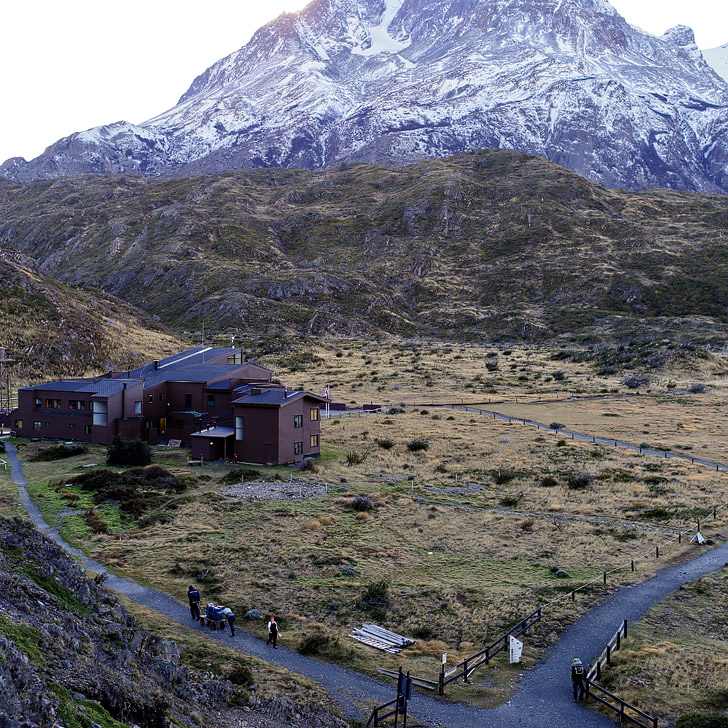 Pin
PinCamping in Torres del Paine
Camping in the park is only allowed at authorized campsites. Book your campsites here.
Authorized Campsites
- Pehoé (Access by Car)
- Río Serrano (Access by Car)
- Grey (Mountain Area)
- Paine Grande (Mountain Area)
- Los Perros (Mountain Area)
- Dickson (Mountain Area)
Free Authorized Campsites
- Las Carretas Campsite – Open all year (has toilets)
- Italiano Campsite – Open from November to April (has toilets)
- Paso Campsite – Open from November to March (has toilets)
- Torres Campsite – Open from November to April (has toilets)
What to Pack
Check out our packing guides specific to each season.
Here are a few things to keep in mind.
- Bring layers! It gets hot when you’re hiking but can be cold when you’re standing still.
- Always be prepared for the worst weather.
- If you’re bringing a camera during the winter, bring extra batteries since batteries drain faster. Also, keep them in your inner jacket pocket and put them in your sleeping bag overnight.
- Bring something to protect your camera from the elements. Our DSLR broke the last day, and it’s currently being taken apart to be repaired.
- Leave your cap or trucker hats at home. I brought one for sun protection, but I almost lost it to the wind several times even though I had it on tight. I ended up strapping it to my bag most of the time. Now, we know why they suggested only a beanie.
What's Nearby
- Puerto Natales (102 km / 1 hr 21 min away)
- Los Glaciares National Park (300 km / 3 hr 47 min away)
- Punta Arenas (343 km / 4 hr away)
- Magdalena Island (close to Punta Arenas)
- Tierra del Fuego (south of Punta Arenas across Strait of Magellan)
Is Torres del Paine on your bucket list?
Did you enjoy this post? Pin it for later
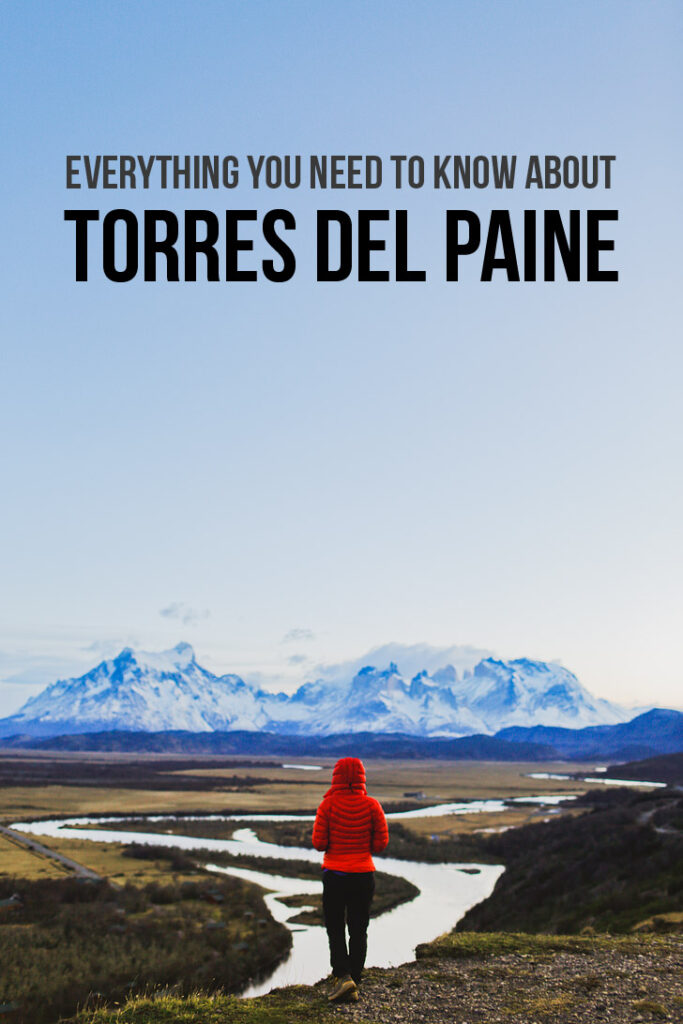 Pin
Pin Pin
Pin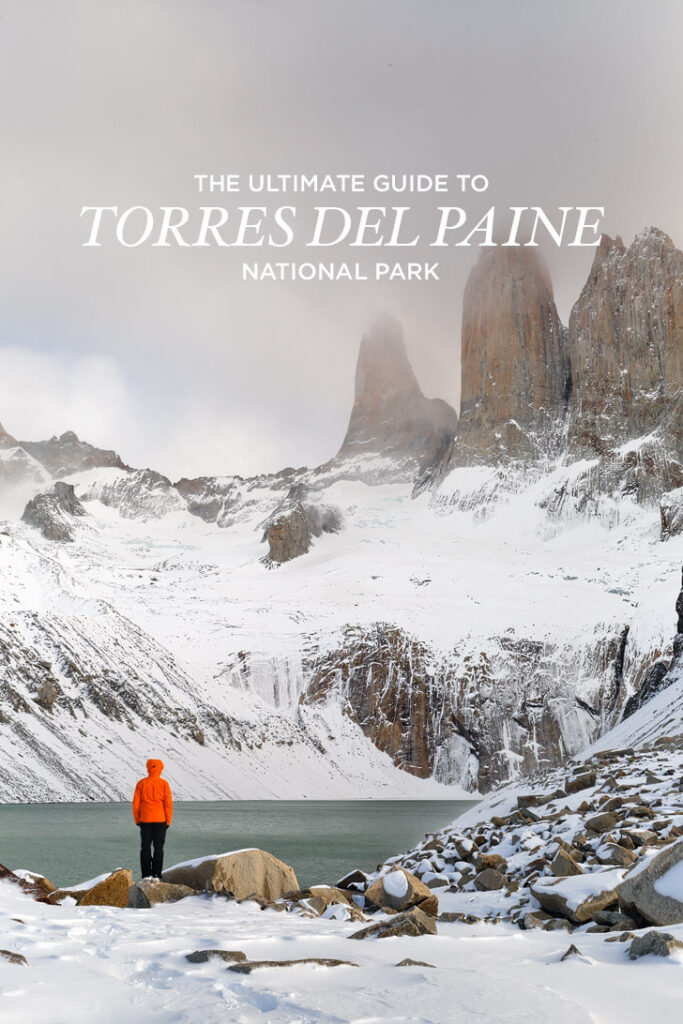 Pin
PinSEE MORE NATIONAL PARK GUIDES
⟡⟡⟡⟡⟡
“Discovery consists not of seeking new lands but in seeing with new eyes” – M. Proust
 Pin
PinEsther + Jacob
Esther and Jacob are the founders of Local Adventurer, which is one of the top 5 travel blogs in the US. They believe that adventure can be found both near and far and hope to inspire others to explore locally. They explore a new city in depth every year and currently base themselves in Las Vegas.


